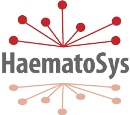HaematoSys
Systembiologie der Hämatopoese und hämatopoetischer Neoplasien
Subproject 1: Modelling the Treatment of Diffuse Large B-Cell Lymphoma
Coordinator: Dirk Hasenclever
Coapplicants: MK (1 PhD, 1 TA), DH/MS (1 PhD)
Associated partners: DSHNHL
Background and own contributions: State of the art treatment of (DLBCL) is a combination of polychemotherapy ( 4-5 drugs) with the monoclonal anti-CD20 antibody Rituximab. Outcome has been improved recently but still is unsatisfactory with cure rates of 60 to 80%. Several open questions concern dosing and timing of both chemotherapy as well as Rituximab. In addition, patients’ characteristics appear to be related to lymphoma growth velocity and chemosensitivity. This calls for a model to assist treatment optimisation. In the past we have developed (i) a model of chemotherapy (“Generalised Skipper model”) that can be fitted to individual data from clinical studies and (ii) a corresponding meta-regression technique to integrate data on treatment comparisons from the literature. For advanced Hodgkin’s lymphoma a model prediction [3.2] was instrumental in designing a large clinical trial [3.4] which indeed led to a 15% increase in cure rates. In addition the model was successful in interpreting new trial data from other study groups in Hodgkin’s disease. At the time, application of this model to DLBCL was hampered by the badly understood heterogeneity of NHL study populations. Lack of individual data precluded the investigation of the impact of patients’ characteristics on optimal treatment. With Rituximab a completely new type of treatment component emerged. Now about 6000 well characterized patients with DLBCL with large follow-up are available from DSHNHL (8 clinical trials, 12 different therapies) [3.6-3.9] and from other trial groups. To overcome the limitation that in humans tumour burden is not observable as a time series we will also use a xenograft mouse model [3.10-3.11].
Objective: Building upon our existing models, we will construct a stochastic model of lymphoma therapy for humans and mice in parallel. In a mouse xenograft model of lymphoma we will be able to measure tumour burden and identify basic mechanisms of action in particular of Rituximab treatment. The model will encompass the dosing and timing effects of various cytotoxic drugs and Rituximab, the relevance of tumour growth and its interaction with chemosensitivity as well as patient or tumour related characteristics influencing the outcome. It should be able to predict both early and late relapses in the human situation in various therapy scenarios and tumour burden time series in mice.
Available data: We have access to trial data of the DSHNHL and we expect additional individual data from other big study groups as the HOVON (NL) and GELA (F) to whom we have good relations.
Work program: Modelling in Mice. We select CD20+ human DLBCL lines of different chemosensitivity and growth velocity. NOD/SCID mice will be grafted with these cell lines to establish disseminated disease [3.12-3.13]. We treat the mice with the most important cytotoxic agents used for the treatment of DLBCL and Rituximab both in several dosing and timing schedules. Corresponding dynamics of tumour burden are measured directly by flowcytometry and correlated with potential surrogate markers like LDH. We construct the therapy model in mice on the basis of the generalized Skipper model. We plan including dose-response relations for major cytotoxic drugs as well as the interaction of tumour growth and chemosensitivity making use of the heterogeneity among tumour cell lines. A pharmacokinetic and -dynamic model of Rituximab will be added. The model will be validated by comparing predictions with experimental data for regimen not used in modelling.
Modelling in Humans. The mouse model will be translated to the human situation by keeping the model structure but assuming new parameter settings. We estimate parameters of the human model by fitting the model to ‘progression free survival’ curves of available study data. At first, we explain early relapses in studies without Rituximab and without dose-escalation of cytotoxic drugs. Then we add a model of residual disease in order to explain late relapses [3.3]. Patient characteristics like the international prognostic index, LDH and tumour subtypes will be modelled as modulators of chemosensitivity, regrowth and initial tumour burden. Modelling dose-intensified regimens, we will estimate dose-response functions. Finally, the effect of Rituximab and its interaction with chemotherapy will be added.

